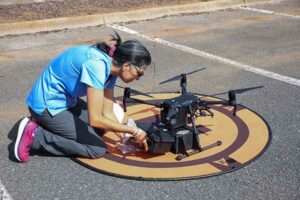Based on the U.S. Department of Agriculture’s Economic Research Service, there are 1,146,765 people living in rural areas in Alabama. That means 23% of Alabama’s population lives in disadvantaged communities that face limitations in health care services and a shortage of resources like doctors, nurses and clinics.
Dr. Azita Amiri, an associate professor of nursing at the University of Alabama in Huntsville’s (UAH) College of Nursing, is working with Casey Calamaio, a research engineer at UAH’s Rotorcraft Systems Engineering and Simulation Center (RSESC), to establish the viability of using drones to expedite the delivery of vital health care services and supplies to patients in rural areas notoriously deficient in resources.

(Michael Mercier/UAH Contributed)
According to Dr. Amiri, the odd collaboration between the doctor and the engineer began two years ago when she connected with the RSESC, and it led to the testing of drone delivery technologies along with a new strategy for educating nurses, to find health care solutions for those communities nationwide.
“We noticed the strong capacity and capabilities of the Unmanned Aircraft Systems Programs at UAH,” Dr. Amiri said. “We’re trying to connect nursing, aerospace, and Unmanned Aircraft Systems and use it in the systems in healthcare to improve nursing care and patient outcome.”
The pair have been working on several projects utilizing drones in telehealth. So far, drone delivery shows promise because it keeps patients at home and avoids any constraints in rural infrastructure on the way.
“Using drones for delivery of healthcare services is well-documented in humanitarian relief efforts or during significant natural disaster events in rural locations across the globe,” Amiri said.
Their work looked at three simulations: an obstetric case, an overdose case and a prototype payload for medical supply delivery.
Led by Dr. Darlene Showalter, all three involved patients arriving at a rural hospital that has encountered supply-chain issues associated with the COVID-19 pandemic, limiting their capabilities and staff.
“We are equipping our students to collaborate and think through real-life issues that serve as obstacles to healthcare equity,” said Dr. Showalter.
Using a drone, an urban clinic sends medicine and supplies to the hospital, where they are unloaded upon receipt, utilized, and then any specimens or test results are returned via the same drone.
“We also had a chance to identify areas with radio frequency interference in urban environments, considerations for UAS traffic management, and to discuss effective ways to introduce UAS in the local medical community,” said Calamaio.
Dr. Amiri said people in rural areas sometimes travel 30 to 40 miles to reach a clinic or a health center in many rural areas.
“This leads to delay in diagnosis, as well as inconvenient patient and physician experiences,” continued the doctor. “They also lead to reduced medication adherence, poor diagnostics for treatment and universal healthcare issues, such as antibiotic resistance.”
Current FAA regulations and rules limit U.S. drone package delivery. Walmart tested drone delivery of COVID-19 testing kits, but it provided service only to patients who lived within a one-mile radius of the designated supercenters to adhere to FAA regulations that the drone must be visible while flying.
“Significant coordination with the FAA to safely implement a rural UAS delivery system is required,” Calamaio advised. “Challenges in assured operational safety and regulatory compliance need addressing before UAS are used as delivery mechanisms on the scale to tilt the medical supply chain in a significant way.”
Don’t miss out! Subscribe to our email newsletter to have all our smart stories delivered to your inbox.



